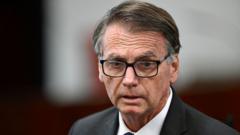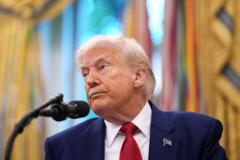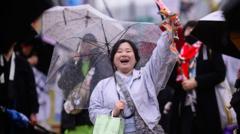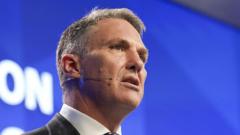With elections brewing, key issues like cost of living, housing affordability, and party dynamics are set to take center stage.
**Australia's Upcoming Federal Election: What to Expect on May 3rd**

**Australia's Upcoming Federal Election: What to Expect on May 3rd**
Australians prepare for the pivotal federal election that will shape the next government and its leader.
The date for Australia’s next federal election has been officially set for May 3, where nearly 18 million voters will participate in a crucial decision-making process that will determine the nation’s next prime minister. This election marks the first since 2022 and is anticipated to reshape parliament’s structure as well.
Australia operates under a distinctive electoral system, combining mandatory voting with a unique preferential voting approach. Citizens over 18 are obliged to cast their votes, often while enjoying the tradition of grabbing a "democracy sausage" at polling stations. The preferential system requires voters to rank candidates by preference rather than simply choosing one, ensuring that the winner secures a majority of over 50% of votes cast. If this threshold isn't met in the first count, the least popular candidates’ votes are redistributed until one candidate emerges as the majority.
In this upcoming election, all 150 seats in the House of Representatives will be contested along with 40 out of 76 Senate seats. The two dominant political parties, the Australian Labor Party (ALP) and the Liberal-National coalition, are vying heavily for control. To establish a majority government, a party needs to win a minimum of 76 House seats. Over recent decades, there has been an increasing inclination toward minor parties and independent candidates, a trend that peaked in the last federal election with one in three voters supporting outside candidates.
Currently, the Labor Party controls a majority of 78 seats following a noteworthy victory in the 2022 election, while the coalition holds 57. With a single House seat disbanded this election, Labor can afford to lose only two seats to maintain their majority. Meanwhile, for the coalition, reclaiming its position would necessitate winning at least 19 additional seats.
The contest for prime minister will chiefly feature Anthony Albanese, the incumbent leader of the Labor Party, and Peter Dutton, who leads the coalition following the latter's significant losses in 2022. Albanese has been a fixture in Australian politics for three decades but faces scrutiny over various issues, including housing, Indigenous policies, and recent rising antisemitism and Islamophobia. Dutton, known for his conservative stance and past ministerial experience, aims to gain traction in his first election as opposition leader, although he has courted controversy in the past regarding social debates.
The foremost concern this election appears to be the cost of living. Economic variables, including inflation rates and increased prices for basic necessities, have adversely affected many Australian households. While the Albanese government has hinted at support mechanisms such as tax cuts and energy rebates, interest rates have risen significantly since 2022, presenting further challenges for residents, particularly in the housing market where affordability remains a pressing issue.
Voters should expect to see results on election night, but the official announcement of seat outcomes will come from the Australian Electoral Commission (AEC) after they complete their counting processes. While the AEC provides an indicative count during the day, formal declarations must await confidence in the results, a process that can take several days following the election.
Australia operates under a distinctive electoral system, combining mandatory voting with a unique preferential voting approach. Citizens over 18 are obliged to cast their votes, often while enjoying the tradition of grabbing a "democracy sausage" at polling stations. The preferential system requires voters to rank candidates by preference rather than simply choosing one, ensuring that the winner secures a majority of over 50% of votes cast. If this threshold isn't met in the first count, the least popular candidates’ votes are redistributed until one candidate emerges as the majority.
In this upcoming election, all 150 seats in the House of Representatives will be contested along with 40 out of 76 Senate seats. The two dominant political parties, the Australian Labor Party (ALP) and the Liberal-National coalition, are vying heavily for control. To establish a majority government, a party needs to win a minimum of 76 House seats. Over recent decades, there has been an increasing inclination toward minor parties and independent candidates, a trend that peaked in the last federal election with one in three voters supporting outside candidates.
Currently, the Labor Party controls a majority of 78 seats following a noteworthy victory in the 2022 election, while the coalition holds 57. With a single House seat disbanded this election, Labor can afford to lose only two seats to maintain their majority. Meanwhile, for the coalition, reclaiming its position would necessitate winning at least 19 additional seats.
The contest for prime minister will chiefly feature Anthony Albanese, the incumbent leader of the Labor Party, and Peter Dutton, who leads the coalition following the latter's significant losses in 2022. Albanese has been a fixture in Australian politics for three decades but faces scrutiny over various issues, including housing, Indigenous policies, and recent rising antisemitism and Islamophobia. Dutton, known for his conservative stance and past ministerial experience, aims to gain traction in his first election as opposition leader, although he has courted controversy in the past regarding social debates.
The foremost concern this election appears to be the cost of living. Economic variables, including inflation rates and increased prices for basic necessities, have adversely affected many Australian households. While the Albanese government has hinted at support mechanisms such as tax cuts and energy rebates, interest rates have risen significantly since 2022, presenting further challenges for residents, particularly in the housing market where affordability remains a pressing issue.
Voters should expect to see results on election night, but the official announcement of seat outcomes will come from the Australian Electoral Commission (AEC) after they complete their counting processes. While the AEC provides an indicative count during the day, formal declarations must await confidence in the results, a process that can take several days following the election.



















